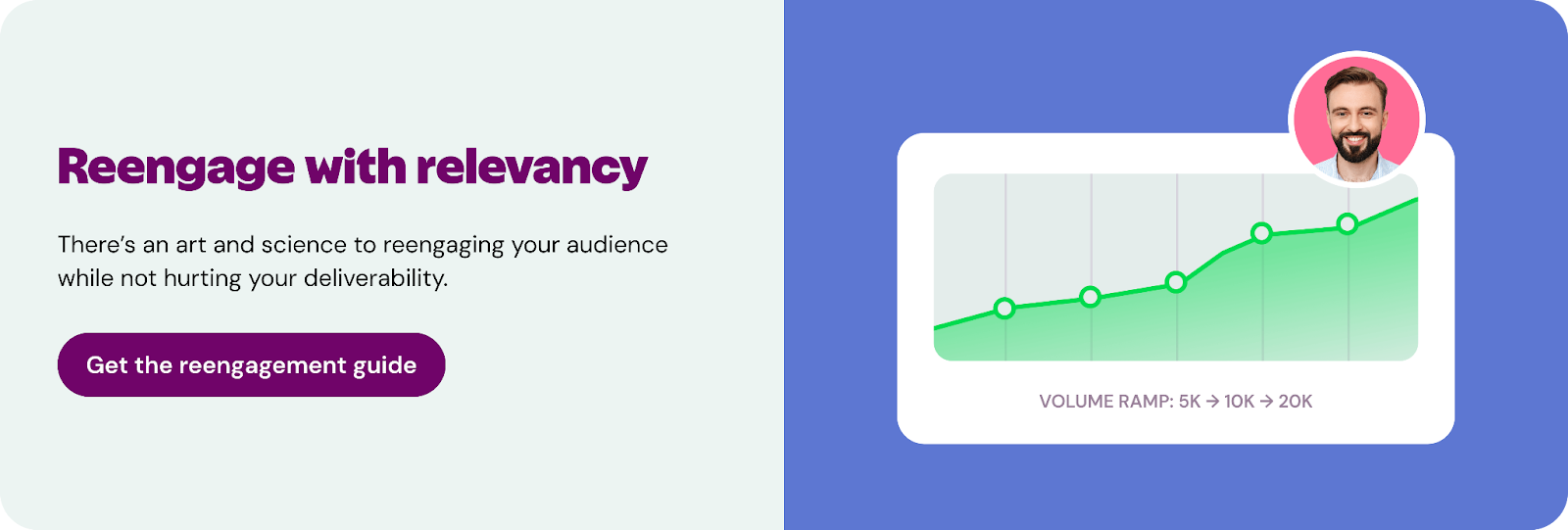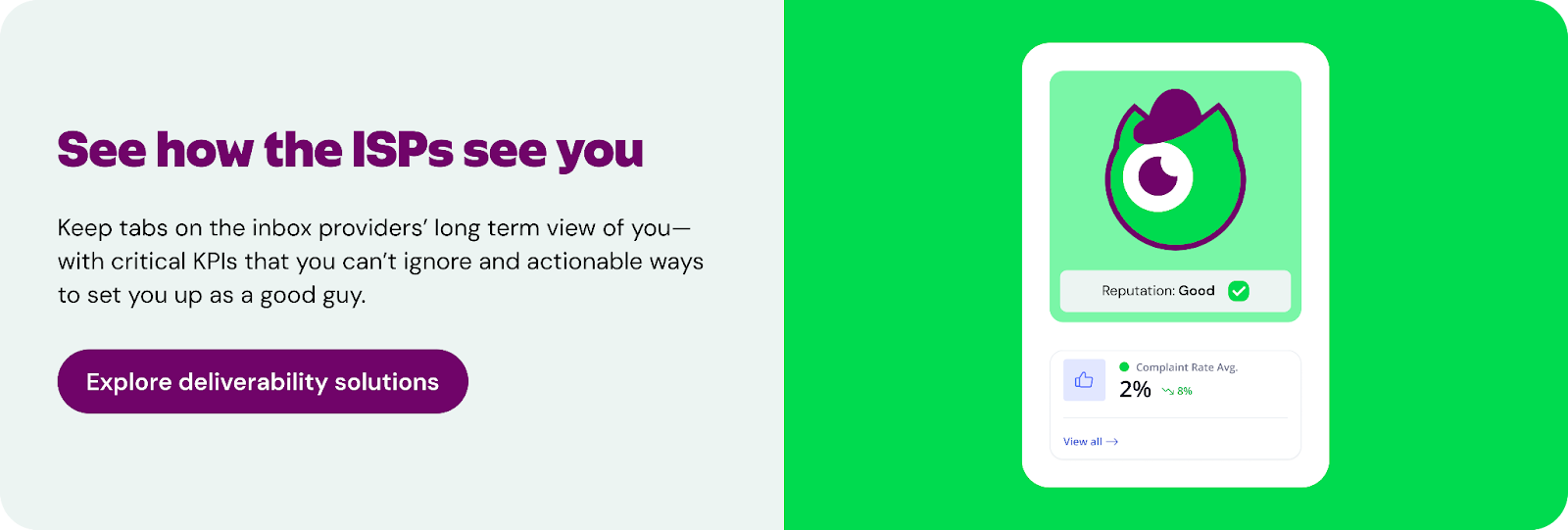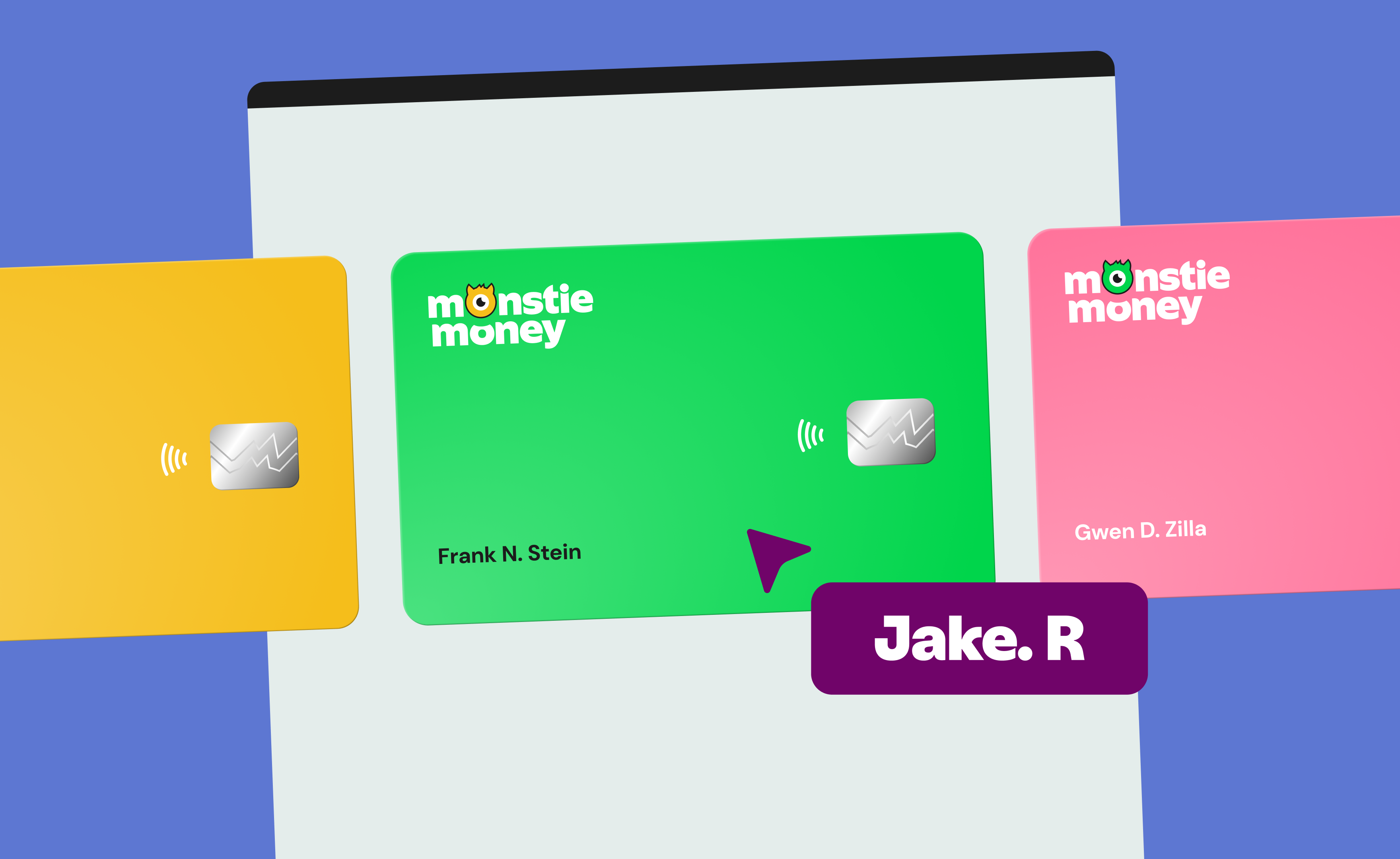The holiday season is a double-edged sword for email marketers. On one hand, people are primed to spend, hunt for deals and open promotional emails with more intent than usual. On the other hand, inboxes get noisier, filters get stricter and even well-meaning marketers can take an unfortunate trip to the spam folder.
Holiday deliverability is a balancing act: how do you send more without sending too much? How do you maximize reach without damaging your reputation?
We’ve rounded up the biggest questions marketers ask every holiday season and put together practical, non-scary answers. Whether you’re gearing up for Black Friday, Cyber Monday or the endless December push, here’s how to stay in good graces with Gmail, Yahoo, and every other inbox gatekeeper.
Here’s the TL;DR
The holiday season puts inbox filters on high alert. This article covers when to start warming (September/October), how to handle Promotions tab placement, why reengaging old subs in November is risky, how much you can send without tanking your reputation and the authentication/compliance checks you can’t skip. With automations as your steady engine and monitoring as your radar, you’ll protect your sender reputation and maximize revenue when it counts most.
Why does deliverability get tougher during the holidays?
The short answer: volume. ISPs like Gmail, Yahoo and Outlook tighten their filters during peak periods. When billions of extra messages hit their servers in late November, the tolerance for risk goes down.
In 2024, Twilio SendGrid processed over 65.5 billion emails during the holiday week starting on the morning of Tuesday, November 26, and ending on the night of Monday, December 2. When you look at year-over-year growth, that’s a huge 15.6%!

What does that mean for marketers?
Recycled lists can suddenly become toxic. A handful of bounces in July might be tolerated. In December, that same activity looks suspicious.
Sudden floods of email can raise red flags, too. If you typically send 200K emails a week and jump to 2M overnight, inbox service providers (ISPs) will see you as unpredictable.
Gimmicky subject lines—the kind that scream “LAST CHANCE!!!”—can spike complaints and land you in the spam folder.
A tactical way to minimize the risk: audit your past holiday performance. Did you notice a sudden drop in inbox placement last December? Were complaint rates unusually high on Black Friday? Use that data as a diagnostic before you start scaling up again.
How early should I start warming up for holiday sends?
Six to eight weeks before Black Friday is the sweet spot. That means starting in late September or early October.
Think of warming up like building muscle memory with ISPs. The more gradually you increase your volume, the more confidence ISPs have that you’re a trustworthy sender.
Here’s what a pre-holiday season warm up could look like:
- Week 1: Send to 25% of your engaged audience (e.g., 20K/day).
- Week 2: Increase to 40K/day.
- Week 3: Increase to 60K/day.
- Week 4: Push to 80K/day, but monitor complaints and bounces closely.
- Weeks 5–6: Layer in less active subscribers slowly, while keeping core engaged segments consistent.
If you find yourself behind schedule, resist the temptation to go full send. Instead, prioritize your most engaged subscribers and build from there.
In addition, keep an eagle eye on email engagement throughout the warm up period for any telltale signs of deliverability issues. Be prepared to stop and reduce volume to avoid bigger issues when you need your email channel the most.
Cutting corners on warm-up usually leads to more lost revenue than fewer sends.
“With holiday sending starting earlier and earlier each year, it’s very possible that early deal senders could run into a very crowded inbox through the middle of November. It might be best to give a little space with your sends, and it will not be surprising if engagement and KPIs are a bit lower YoY with the extra volume going out.” - Pilar Bower, Sr. Deliverability Consultant, Inbox Monster

Do Gmail and Yahoo tabs (Promotions, Updates) hurt my holiday performance?
The Promotions tab is not the enemy. In fact, it can be a signal boost when used correctly.
Why? Because people check their Promotions tab when they want to shop. It’s a curated marketplace of offers. As long as your subject lines are clear and your brand is recognizable, placement in Promotions can yield high engagement.
- Make sure your From name is consistent. Holiday inboxes are crowded, so brand recognition helps. Avoid the temptation to use Holiday specific subject lines that might not be as recognizable—or be trimmed.
- Use preview text wisely. Think of it as the subject line’s partner in crime.
- Don’t try to “trick” your way into Primary. ISPs use advanced filtering, and fake personalization or misleading language can trigger complaints.
“You might want your emails to land in the Primary tab but consider where your subscribers and customers want your emails to appear. It might feel like an intrusion in their inbox if your promotional emails land anywhere but the Promotions tab. This might lead to a simple deletion or unsubscribe—or worse—a spam complaint.” - Laura Sullivan, Head of Brand and Marketing, Inbox Monster
Should I re-engage old subscribers just for Black Friday/Cyber Monday?
This is one of the most common mistakes marketers make in an effort to reach as many people as possible. Re-engaging dormant subscribers in November is a recipe for disaster.
Instead, run your reactivation campaigns early: September or October. That gives ISPs time to evaluate whether your subscribers actually want to hear from you.
- Pull a segment of subscribers who haven’t opened in 6–12 months.
- Send a reactivation series with clear options: “Do you still want holiday deals from us?”
- If they don’t engage after two or three attempts, suppress them for the season.
This approach keeps complaint rates low and protects your reputation during the most critical time of year.
“Get started with some re-engagement tactics sooner rather than later. Try identifying your best content from the year and repackaging it in a clever way to get the less active subscribers’ attention. Take a page from one of our retail clients and do a pre-holiday sale now to see how your list responds.” - Thom Porter, Sr. Deliverability Consultant, Inbox Monster

How many emails can I send without tanking my reputation?
There’s no universal “safe” number. What matters is engagement and segmentation.
Consider segmenting your audience by those who are most engaged vs. the lowest engagers. Send more frequently to your most engaged audience while treating your less engaged customers with kid gloves:
- VIPs (high openers/clickers): Send daily during Black Friday weekend. They’ve shown an appetite for your content.
- Moderates (engaged but less frequent): Stick to 2–3 emails per week.
- Low engagers (rarely open): One targeted message per week, or suppress entirely.
ISPs also look for pacing consistency. Instead of blasting your entire list at 9 AM, throttle by ISP or stagger across time zones. Many senders see improved inbox placement simply by distributing campaigns over a 12–24 hour window.

What subject line tactics work best (and which backfire)?
The temptation to go “all caps urgent” and stuff every possible emoji into subject lines for the sake of being seen is real. But filters—and subscribers—punish gimmicks.

To refine your subject line strategy, run A/B tests before peak season. You might want to consider using your year-round campaigns as a testing ground to walk into the busy holiday season with some data-backed tactics.
There is one caveat to that: subscribers and customers often behave completely differently in the inbox during the busy holiday season vs. any other time of the year. They’re more likely to be hunting deals, coupon codes and anything that’ll give them a discount.
“Emojis are great when used in moderation. Also, avoid what I like to call “hysterical” subject lines filled with multiple emojis, ALL CAPS, and excessive exclamation points. While you are competing with many other marketers who use this tactic, you want to appear less “desperate.” - Josie Garcia, Sr. Deliverability Consultant, Inbox Monster
What authentication and compliance checks should I run before November?
Technical alignment is non-negotiable during the holidays. Even the best email strategy won’t help if your authentication is broken.
Before ramping up email volume in preparation for the holiday season, remember to:
- Verify SPF, DKIM, and DMARC records are aligned.
- Enable BIMI for added trust (logos build confidence during shopping season).
- Double-check you still meet Gmail, Yahoo, and Microsoft’s sender requirements:
- One-click unsubscribe is required.
- Keep complaint rates below 0.1%.
- Use consistent From: addresses to build trust signals.
Inbox Monster’s Holiday Deliverability Guide is a great resource for tightening these checks before filters get stricter.
Which automations should I lean on during the holidays?
Broadcast and promotional email campaigns may spike, but automations provide stability. They keep your sender reputation steady by generating consistent engagement.
Consider prioritizing tweaks and optimizations for these automated emails and customer journeys:
- Welcome flows: Make sure your first impression reflects holiday themes but doesn’t overwhelm.
- Cart abandonment: Shoppers get distracted. A reminder with urgency (“Still want that gift? Sale ends tonight!”) brings them back.
- Post-purchase thank-you: A personalized note (maybe with a “treat yourself” upsell) builds loyalty.
Layer seasonal promotions into these flows, but don’t break the cadence. The continuity tells ISPs you’re not a one-month spammer.

How do I know if my deliverability is slipping mid-campaign?
You can’t fix what you can’t see. That’s why monitoring is essential during the holidays.
You don’t have to monitor everything. Here’s what’s worth keeping an eye on daily:
- Bounce rates: A sudden spike can mean ISP throttling.
- Complaint rates: Even a 0.2% complaint rate can tank placement.
- Trap hits: A sign your list hygiene has slipped.
- Inbox placement: Test with seeds and panels daily during Black Friday/Cyber Monday.
Inbox Monster’s monitoring and trap intelligence tools give you real-time visibility. Think of them as your radar system for spotting turbulence before it crashes the campaign.
How should I reset after the holidays?
There’s always a little fallout once the busy holiday season ends. Many people sign up purely for holiday deals, and once January hits, they disappear. That’s not necessarily a bad thing.
The worst-case scenario isn’t an unsubscribe—it’s subscribers sticking around silently, dragging down your engagement for months. An unsubscribe keeps your list healthy; inactivity quietly erodes your reputation.
Here’s how you can avoid a slip in your reputation:
- Dial back your frequency: Focus on your core engaged subscribers and give everyone else breathing room.
- Invite preference updates: A simple “How often do you want to hear from us in 2026?” email can help filter seasonal shoppers from loyal fans.
- Let go of chronic non-engagers: Suppressing these addresses protects you long term.
And don’t treat the unsubscribe as a dead end. Look for other ways to keep light-touch connections—social, SMS, or even direct mail—so you can nudge seasonal buyers back toward the inbox when the next holiday cycle begins.
“There’s inevitable fallout after lots of customers just sign up for emails for holiday deals. The unfortunate truth: Don’t get too excited about a spike. Or too depressed about the exits afterward. It’s better to have your seasonal subscribers unsubscribe rather than ignore your emails for an extended period of time. Try to find ways to stay connected on other digital channels so that you can nudge these seasonal subscribers back to the email channel leading up to next year’s holidays.” - Brad Van der Woerd, Head of Customer Success, Inbox Monster
Good Deliverability is Essential to a Great Holiday Season
Holiday deliverability doesn’t have to be a nightmare before Christmas. With early warm-ups, clean lists, thoughtful frequency and strong automations, your emails can rise above the noise.
Remember: ISPs reward consistency, subscribers reward clarity, and the brands that thrive are the ones that prep early.






